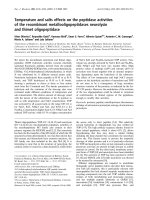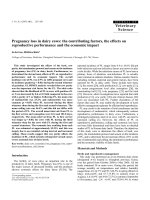The relationship between an organization’s structure and culture and the effects on business performance
Bạn đang xem bản rút gọn của tài liệu. Xem và tải ngay bản đầy đủ của tài liệu tại đây (192.65 KB, 10 trang )
Website: Email : Tel (: 0918.775.368
TABLE OF CONTENTS
I. Introduction:............................................................................2
II. Detail:......................................................................................3
1. Evaluate and compare different organizational structures and culture:.........3
2. The relationship between an organization’s structure and culture and the
effects on business performance:.............................................................................8
3. The factors which influence individual behavior at work:................................9
4. Organization theory strengthens principles and practice of organizing and
management.............................................................................................................12
Classical management theory.................................................................................12
5. The different approaches to management and theories of organization used
by Microsoft:.............................................................................................................14
6. The different leadership styles and the effectiveness of these leadership
approaches in Microsoft Corp. :.............................................................................16
Conclusion:................................................................................17
Reference :.................................................................................18
1
Website: Email : Tel (: 0918.775.368
I. Introduction:
In the case of Microsoft Corp. Software Company, after 27 exist years, Microsoft network is
broadened in 105 countries and region with 78000 people
1
. The success of Microsoft is a proof for
management’s talent of William H. Gates and Steven A. Ballmer although they have a different
management way. Have a question is given: What is the best way for management? There are not
any adequate answers for this question. However, in management the talent of overview, foreseen
and observes are necessary to evaluate flexible most.
1
Microsoft Corporation (2007, July 30) Bill Gates-Chairman, Microsoft Corp. Retrieved March 24, 2008, Web site:
/>2
Website: Email : Tel (: 0918.775.368
II. Detail:
1. Evaluate and compare different organizational structures and culture:
Getting the structure right is important for any organization, whatever its size, its technology
or its environment. In this point of Child’s view, it is claimed:
“The allocation of responsibilities, the grouping of functions, decision - making, co –
ordination, control and reward – all these are fundamental requirement for the continued operation
of an organization. The quality of an organization’s structure will affect how well these
requirements are met.”
2
Depend on environment, technology and tasks or strategy of management, each organization will be
structured to meet its objective or motivate workers. Organization structure can be broken down into
two main types: function and division.
“A function is a set of people who perform the same types of tasks or hold similar
positions in an organization.”
“A division is a group of functions created to allow an organization to produce and
dispose of its goods and services to customers.”
3
Besides, authority/power is also a factor influencing on “shape of organization”. The span of
control is a tool to evaluate authority and hierarchy structure is “flat” or “tall”. It is mean that an
organization with the narrow span of control and high level will lead to tall structure. In contrast,
wider span of control and low level is result in flat structure. The figure below is about
organizational pyramid what shows you span of control, overall.
2
Child J. (1988). Organization: A guide to Problems and Practice. Paul Chapman.
3
Veeramuthu (2008) Organizations and Behavior, Hanoi: National Economic University. 2- page handout on the
Organizational Structure and Culture.
3
Website: Email : Tel (: 0918.775.368
Figure 1.1. Organizational pyramid
4
Relate to hierarchy, authority can be recognized under an aspect of centralize or decentralize. In the
centralized organizations, managers retain most of responsibilities and the power concentration in
one person. In contrast, decentralized organizations disperse responsibilities and decisions for lower
level managers. At all, each organization will decide what combination is most effective.
Making up a right structure is not enough for an organization to run clearly and effectively.
Organizational culture is also remarkable. As the same as other concepts, there are many way to
define organizational culture. One of the definition is described as follow:
“Culture (in the sense of organizational ‘climate’) is the collective self-image and style
of the organization; its shared values and beliefs, norms and symbols”
5
Each organization has different expectations, values, norms and ways to adapt and identify its
culture. Thus, culture in each organization is unique. For example: if relationship of customers is
cared of the culture, this distinction will be adopted by individuals. However, following the ideas of
4
EDEXCEL HNC & HND BUSINESS, (2004) Mandatory Unit 3: Organizations and Behavior Supporting foundation
degrees. 1
st
ed., London: BPP Professional Education, Aldine House, Aldine Place, pp. 64.
5
EDEXCEL HNC & HND BUSINESS, (2004) Mandatory Unit 3: Organizations and Behavior Supporting foundation
degrees. 1
st
ed., London: BPP Professional Education, Aldine House, Aldine Place, pp. 103.
4
Website: Email : Tel (: 0918.775.368
Harrison, Handy classify four main types of organizational culture: power, role, task, and person
culture.
6
Within power culture, power is central by judgment of key individual. In role culture,
individuals pay attention to their particular job. Furthermore, task culture based on job satisfaction
and expert power. Finally, person culture takes individual as central focus and talent of individual is
target for structure exists.
As we mentioned about organizational structure and culture before, now we will look through
the case scenario of Microsoft; the article “Ballmer’s Microsoft” that published in Business Week on
17
th
June, 2002; to understand more clearly:
• Under management of Gate:
Building a Microsoft basic foundation, Gates paid attention to develop production “the
Windows operating system and Office suite of applications” that he believed more customers’
attraction and competition moves. To be convenient for product development and management, he
divided company following functional structure. “Gates gave his pal free rein to restructure the way
Microsoft manages finance, sales, product development, marketing, even strategic planning”.
Concentrate to production, Microsoft employees worked in smaller groups and all product activities
were done at one site. It is reason why the amount of Microsoft’s products was always competitive
comparing with other company in the industry. “We have always had a multi-product strategy
where the product managers and the development teams are the champions, and that is a process
that has allowed us to have many more products than any one else in the industry”.
7
In general,
with the Microsoft’s goal at this time, organization structure that Gate created is suitable. To manage
employees pretty well he used flat structure with narrow span control for office. Hierarchy was
centralized that Gate handed most of power. It is true as Jame Collins said: “To my mind, Microsoft
has never been a company. It's a single remarkable individual, Gates, with thousands of the
smartest, best-paid people anywhere helping that individual. It's basically like a big wheel, with
Gates at the hub.”
8
The authority of Gates covered around company and the last decision in hand.
One of the evidence for his strong power is he had his own “think week” when he can think a new
strategy in technology. This proof seems like simple but it expresses that he is such an important and
6
Handy C.B. (1993). Understanding Organizations. Penguin
7
Lalonde J.E. (1990,Feb. 18). A Billion-Now Microsoft's Chairman Bill Gates Needs A New President For The '90S.
Retrieved April 17, 2008, Web site: />site=
8
Gates, Bill Leadership the Bill Gate way. Retrieved April 17, 2008, Web site:
/>%20Gates%20Way-Leadership%20and%20Entrepreneurship.htm#Introduction
5









